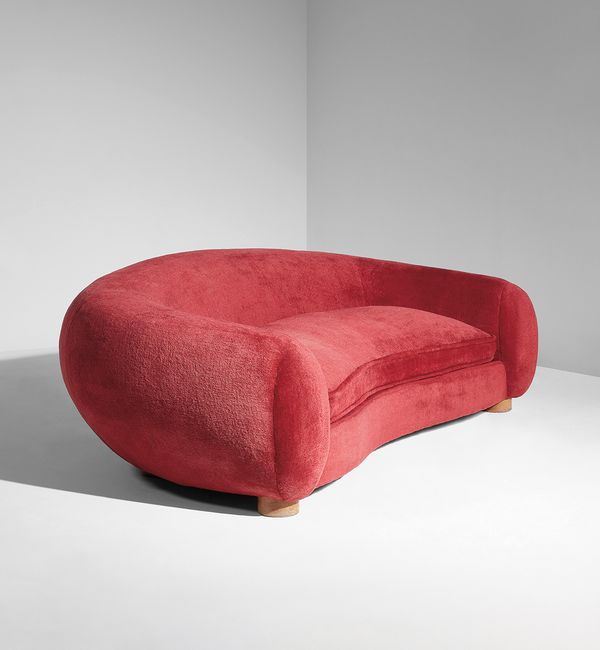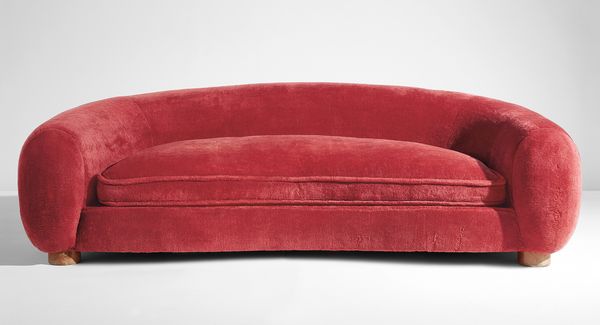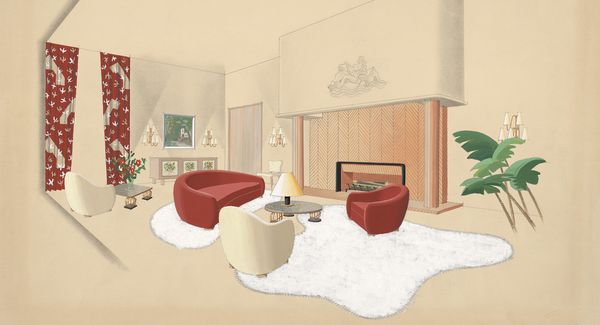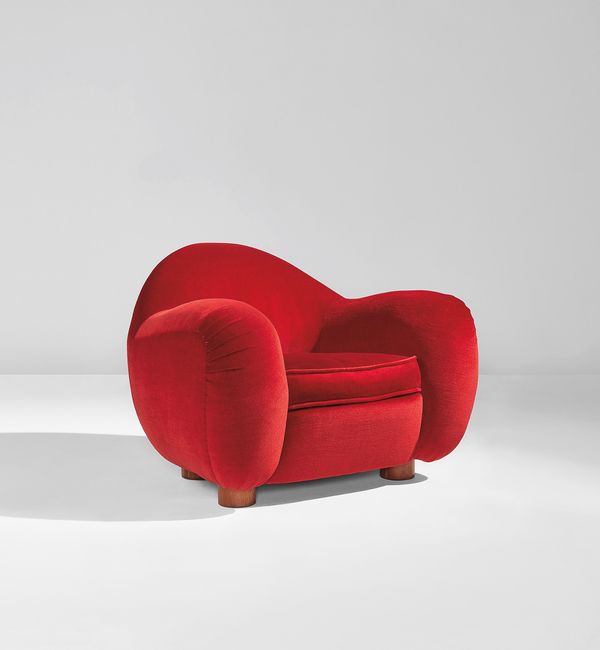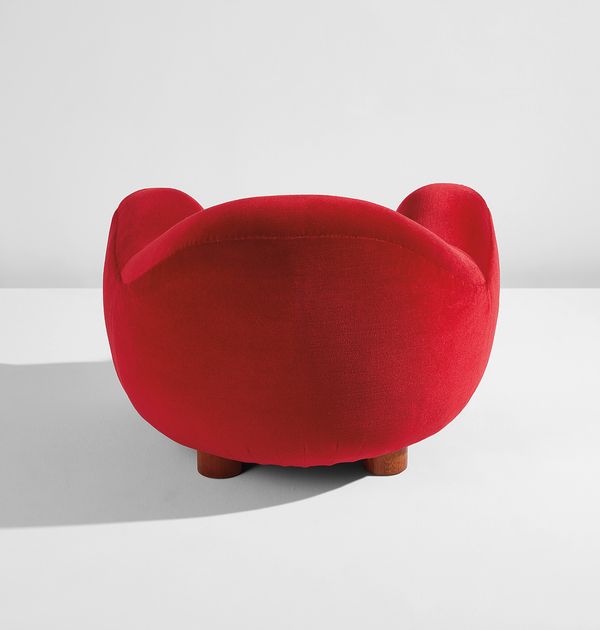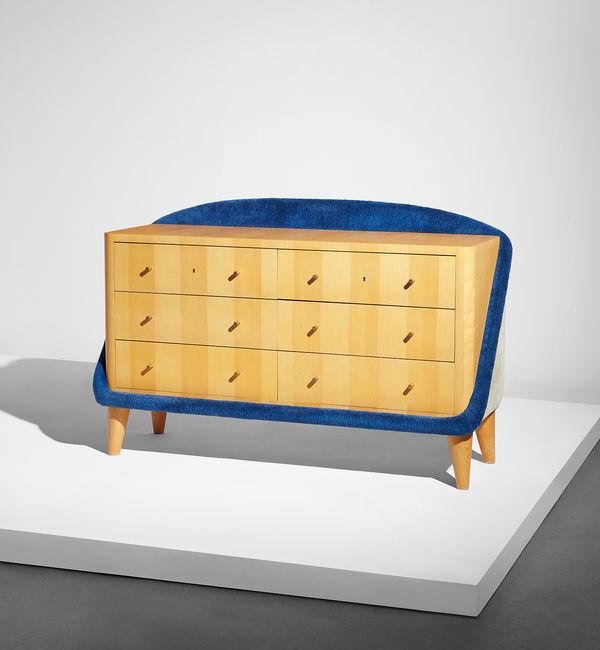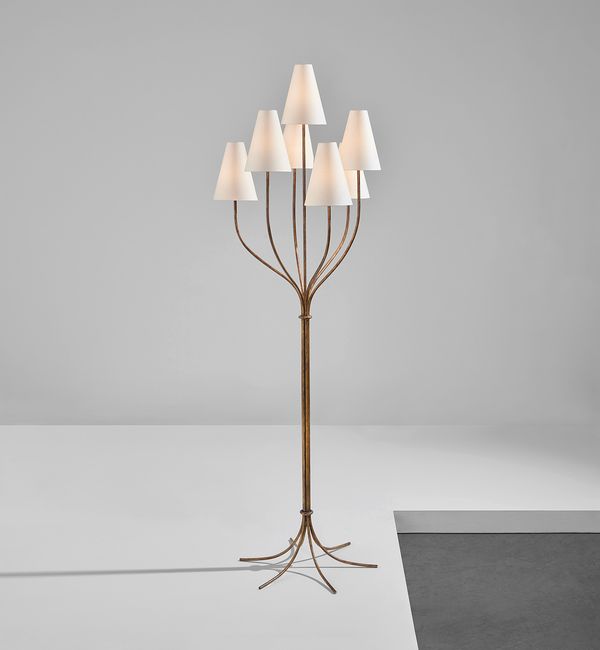Jean Royère "Ours Polaire" sofa, 1950s. Estimate: $300,000 - 500,000.
Design at Phillips New York, 17 December.
Royère first designed one of his most recognizable pieces, the Ours Polaire sofa, for the rooms he occupied in his mother’s apartment at 234 rue du Faubourg-Saint-Honoré on the occasion of redecorating her residence in 1947. This example now resides in the collection of the Musée des Arts Décoratifs, Paris. Later that year he presented the sofa at La Résidence française, an exhibition organized by the publication Art et Industrie. The sofa became ubiquitous in Royère’s interiors of the late 1950s and early 1960s. Today it is recognized as one of his most iconic and sought-after designs.
Jean Royère "Ours Polaire" sofa, 1950s. Estimate: $300,000 - 500,000.
Design at Phillips New York, 17 December.
The soft round form of the Ours, which practically eliminates the typical parts and structure of most seating in favor of one continuous curve, is in keeping with Royère’s whimsical aesthetic as well as the biomorphic style already in full force in the 1950s. Yet while other designers worked with new materials and techniques to achieve their organic forms—Eero Saarinen’s fiberglass Womb chair and the Eameses' use of molded plywood come to mind—the Ours relied on traditional cabinetmaking methods to achieve its novel shape. Photographs of an Ours frame, likely taken in the courtyard of an artisan in the Faubourg Saint-Antoine, show the complex wooden understructure that served as the initial armature. To this carcass, a metal frame padded with horsehair further defined the form, which was finally covered by the fabric upholstery, typically a plush velvet sourced from Italy.
Jean Royère Projet pour le grand salon de la Légation de France à Helsinki en Finlande, 1950. Paris, musée des Arts décoratifs. Image © MAD, Paris. Artwork © 2019 Artists Rights Society (ARS), New York/ADAGP, Paris.
The present lot retains the original thick red upholstery, a color that Royère particularly favored for this design. He used it for the Ours sofas he created for the French legation in Helsinki, depicted in a beautifully rendered gouache in the collection of the Musée des Arts Décoratifs (1950), as well as for the salon at the Maison de France in Rio de Janeiro (1955-1960).
Jean Royère "Boule" armchair, circa 1957. Estimate: $120,000 - 180,000.
Design at Phillips New York, 17 December.
The form of the present Boule armchair, a variation of the lower-back version now commonly referred to as the Ours Polaire armchair, had been exhibited by Royère as early as 1942 in the Salon des artistes décorateurs.
This particular armchair was acquired in 1957 from the architect Nadim Majdalani in Beirut. Majdalani had met Royère in Paris and subsequently, in the late 1940s, the two opened an office of decoration and architecture together under both their names on Avenue des Français in Beirut. The collaboration would continue into the 1960s. Majdalani also owned a furniture workshop and began to execute Royère’s designs according to the detailed plans he had sent over from Paris. Nadine Begdache, the daughter of Majdalani, recounted that Royère’s furniture was “distinguished by their originality and their audacity…Everything he imagined was of great freshness and above all great comfort .”
Jean Royère "Boule" armchair, circa 1957. Estimate: $120,000 - 180,000.
Design at Phillips New York, 17 December.
Royère and Majdalani would go on to collaborate on a large number of both residential and commercial interiors throughout Lebanon, which at the time was experiencing a great deal of growth and new construction. These interiors appeared in French publications throughout the period, with Nadim Majdalani noted as a collaborator in the captions. For his part, Royère loved to travel and, throughout his career, sought out new markets across the world. As he recounted in 1963, “What you have to remember is that in these new and developing countries, cooperation between architect and decorator is facilitated by the fact that, unlike in France, people don’t spend their time patching up and modernizing old buildings.”
Jean Royère Rare "Œuf" chest of drawers, circa 1956. Estimate: $100,000 - 150,000.
Design at Phillips New York, 17 December.
Taking the extant Œuf chair as a point of departure, Royère later created a range of related Œuf furniture that included the present work as well as a sofa, a tabouret, a bed, bedside tables and a coiffeuse. In each example, a soft upholstered shell envelops the inner structure, in this case, a chest of six drawers. Royère designed the Œuf chair in 1954 and it became a regular fixture in his interiors. The other Œuf furniture, however, is much less ubiquitous, documented in only a few places. The November 1958 issue of Mobilier et Décoration illustrated the bedroom suite, noting the “voluptuous rotundity” of the armchairs and bed and the “energetic contrast” of the two-toned upholstery.
Jean Royère "Persane" floor lamp, circa 1954. Estimate: $60,000 - 80,000.
Design at Phillips New York, 17 December.
Royère featured his Persane floor lamp in the 1954 Salon des arts ménagers as part of a bedroom setting alongside an Œuf chair in fuzzy gray and red upholstery and a Flaque coffee table in black straw marquetry with a constellation of golden straw stars. Against a large light green curtain in the background, the long graceful arms of the Persane stood “gushing like meteors to carry off the light,” in the words of René Chavance, who reviewed the Salon for the April 1954 issue of Mobilier et Décoration.
In the same article, Chavance praised Royère for having a refined taste that “blends…with a spiritually fanciful invention.” One of the key characteristics of this fanciful inventiveness was Royère’s use of shaped metal rods, which he explored throughout his lighting repertoire. Sometimes they appear, like in the Persane, as a tidy bundle of branches, while in other instances they undulate across the wall, or, in the case of the Liane, sprawl like an unkempt vine or a hand-drawn line.
